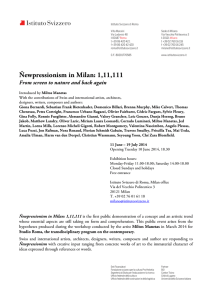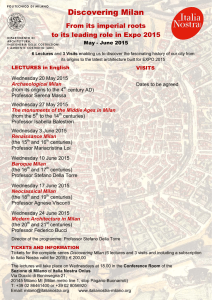IDPA - CNR
advertisement
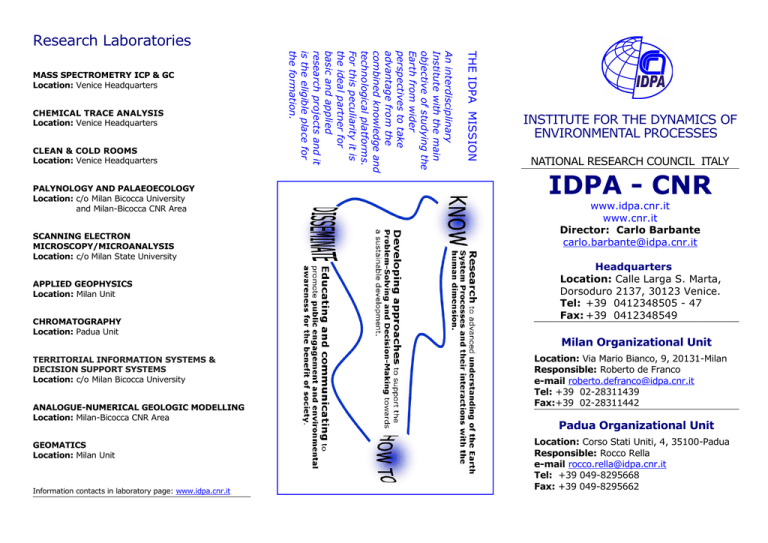
Research Laboratories CLEAN & COLD ROOMS Location: Venice Headquarters PALYNOLOGY AND PALAEOECOLOGY Location: c/o Milan Bicocca University and Milan-Bicocca CNR Area SCANNING ELECTRON MICROSCOPY/MICROANALYSIS Location: c/o Milan State University APPLIED GEOPHYSICS Location: Milan Unit CHROMATOGRAPHY Location: Padua Unit TERRITORIAL INFORMATION SYSTEMS & DECISION SUPPORT SYSTEMS Location: c/o Milan Bicocca University ANALOGUE-NUMERICAL GEOLOGIC MODELLING Location: Milan-Bicocca CNR Area GEOMATICS Location: Milan Unit Information contacts in laboratory page: www.idpa.cnr.it THE IDPA MISSION CHEMICAL TRACE ANALYSIS Location: Venice Headquarters An interdisciplinary Institute with the main objective of studying the Earth from wider perspectives to take advantage from the combined knowledge and technological platforms. For this peculiarity it is the ideal partner for basic and applied research projects and it is the eligible place for the formation. MASS SPECTROMETRY ICP & GC Location: Venice Headquarters INSTITUTE FOR THE DYNAMICS OF ENVIRONMENTAL PROCESSES NATIONAL RESEARCH COUNCIL ITALY IDPA - CNR www.idpa.cnr.it www.cnr.it Director: Carlo Barbante carlo.barbante@idpa.cnr.it Headquarters Location: Calle Larga S. Marta, Dorsoduro 2137, 30123 Venice. Tel: +39 0412348505 - 47 Fax: +39 0412348549 Milan Organizational Unit Location: Via Mario Bianco, 9, 20131-Milan Responsible: Roberto de Franco e-mail roberto.defranco@idpa.cnr.it Tel: +39 02-28311439 Fax:+39 02-28311442 Padua Organizational Unit Location: Corso Stati Uniti, 4, 35100-Padua Responsible: Rocco Rella e-mail rocco.rella@idpa.cnr.it Tel: +39 049-8295668 Fax: +39 049-8295662 The National Research Council (CNR) is a public national research organisation founded in 1923, whose primary role is to carry out advanced basic and applied scientific and technological research. The Institute for the Dynamics of Environmental Processes (IDPA) - CNR was founded in 2001 thanks to a restructuring process that grouped existing CNR Institutes and Centres located both in Venice, Milan and Padua: the “Centre for Studies on Environmental Chemistry and Technologies” Venice, the “Centre for Studies on Alpine and Quaternary Geodynamics”, part of the “Institute for Research on Seismic Risk” – Milan, and the staff of the CNR area of the “Prevention and Protection group” – Padua IDPA borns as an interdisciplinary Institute with the main objective of studying the Earth System from wider perspectives to take advantage of both the interdisciplinary nature of the combined knowledge already available and the synergies between the various disciplines. IDPA is one of the CNR centres of excellence for both basic and applied research in the environmental field, as testified by the variety and quality of publications in qualified international scientific journals, and the participation in national and international scientific projects. paleobiological and paleoclimate dynamics; morphogenesis and evolution of the land; anthropogenic pollution and contamination; environmental hazard scenarios; mobility and transport of the microcomponents throughout the environment. modelling, preparedness and emergency support systems, human sensor enablement and exploitation, natural and geoheritage assessment, georesources assessment. ERT Tomography image of saltwater intrusion in the Venice Lagoon. - Methods and techniques for studying and representing the environment: Innovative models for representing environmental phenomena both in space and time, field geology, analogue geologic modelling, cartography and GIS, apps & 3D technologies, applied geophysics, petrophysics, mineralogy, archeometry, geoarcheology, artifact degradation, human-environment interaction evaluation. - Dissemination Scientific and divulgative publications, educational and professional teaching and tutoring, organization of exhibitions, field trips, lectures, consultings. The advanced instrumentations of the laboratories of the IDPA, together with the available expertise, have been the base requirements for participating and leading national and international research projects with wide and interdisciplinary scopes. Disciplinary area: Earth and Environmental Sciences Main research Themes: - History and evolution of the environmental systems: The topics include but are not limited to the following themes: geodynamics, cryosphere, - Methods for environmental monitoring, valorization, protection and prevention The topics include environmental geophysics, environmental geochemistry, magnetism, applied geomorphology, multi-hazard and risk SEM picture of bacteria on gypsum crystals from anoxic basins.
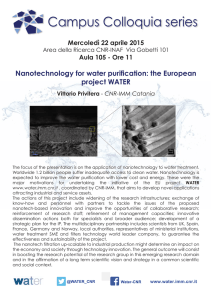
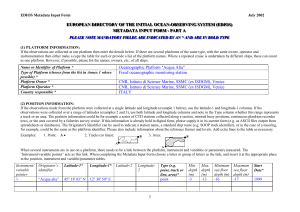

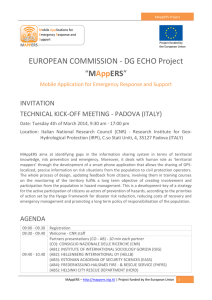
![Programma evento 7 novembre [1]](http://s2.studylib.net/store/data/005471925_1-850048c6dc80e84794a3eea05eb83c23-300x300.png)

